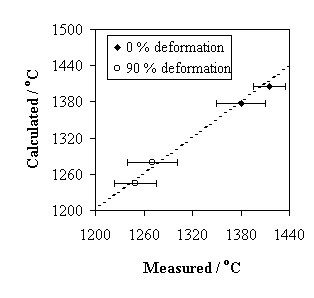
C. Capdevila and H.K.D.H. Bhadeshia,
Phase Transformations Group,
Department of Materials Science and Metallurgy,
University of Cambridge,
Cambridge CB2 3QZ, U.K.
E-mail: cc226@cus.cam.ac.uk
Added to MAP: October 2000.The recrystallisation behaviour of PM2000 oxide dispersion strengthened ferritic alloy has been investigated for samples which were cold deformed after extrusion. This program deals with the evolution of the recrystallisation temperature TR, defined as the minimum temperature at which the sample begins to recrystallise during heat treatment for one hour, as a function of the level of deformation and the heating rate.
|
Language: |
Fortran 77 |
|
Product form: |
Source code |
Complete program.
PM2000 is an iron-base superalloy designed for power plant applications, strengthened with yttria particles [1]. It is manufactured by mechanical alloying [2], in which elemental powders or compounds are heavily deformed while in intimate contact, to such large strains that the mechanical mixture of powders changes into a solid solution, with the exception of the yttrium oxide particles which are dispersed uniformly. The alloyed powder is then canned and hot extruded; the microstructure at this stage consists of incredibly fine (0.5 micrometers) equiaxed [3]. Subsequent annealing at exceptionally high temperatures, of the order of 0.9 of the melting temperature, yields recrystallised grains which are columnar and aligned along the extrusion direction giving excellent creep strength along the tube axis. The columnar growth is primarily a consequence of the alignment of oxide particles along the extrusion direction. However, in pressurised tubes, the maximum principal stress is in the hoop direction where the tubes are weakest in creep. To improve the hoop strength, tubes are deformed in torsion prior to heat treatment, in order to recrystallise the material into a helical grain structure which follows the twisted alignment of the oxide particles [4,5].
Calculations using the model and experimental values obtained for PM2000 illustrate the variation in TR as a function of heating rate and of the deformation level. A comparison between calculated and predicted results is presented in Fig. 1. The results confirm that recrystallisation can be expected to occur at higher temperatures as deformation becomes more uniform. Furthermore, the increase of TR with the heating rate is more important at about 50% in reduction in area, when deformation is most heterogeneous.

None.
No information supplied.
None.
Complete program.
TM=1482 oC
|
Temperature |
Frac. Recrys. |
Deformation Level |
|
1378 |
0.502838E-01 |
0 |
|
1178. |
0.523008E-01 |
10 |
|
1018. |
0.518034E-01 |
20 |
|
906. |
0.510580E-01 |
30 |
|
846. |
0.529337E-01 |
40 |
|
834. |
0.559039E-01 |
50 |
|
866. |
0.540186E-01 |
60 |
|
946. |
0.518452E-01 |
70 |
|
1074. |
0.512006E-01 |
80 |
|
1244. |
0.517920E-01 |
90 |
none
ODS, Ferritic Steel, Steel, Recrystallisation
MAP originated from a joint project of the National Physical Laboratory and the University of Cambridge.
Top | Program Index | MAP Homepage